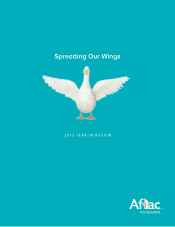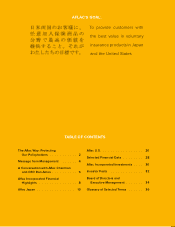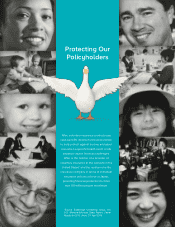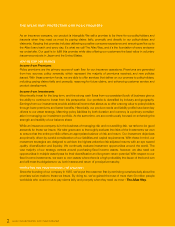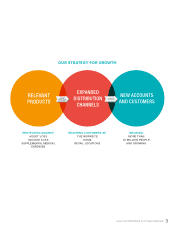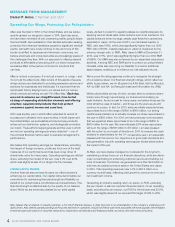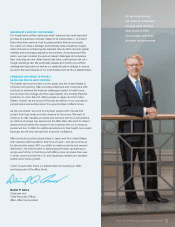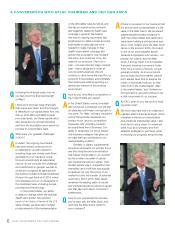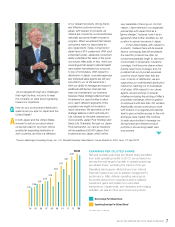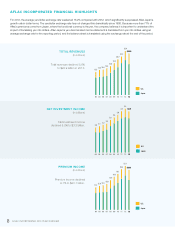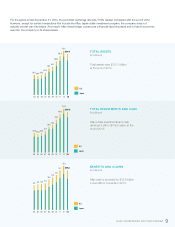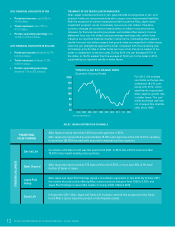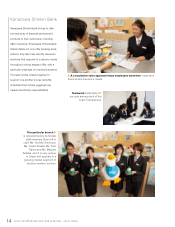Aflac 2013 Annual Report Download - page 6
Download and view the complete annual report
Please find page 6 of the 2013 Aflac annual report below. You can navigate through the pages in the report by either clicking on the pages listed below, or by using the keyword search tool below to find specific information within the annual report.
MESSAGE FROM MANAGEMENT
Daniel P. Amos, Chairman and CEO
Aflac was founded in 1955 in the United States, and we subse-
quently spread our wings into Japan in 1974. Each day since,
we have been reminded of one unwavering reality: people desire
the best health care available for their families while also seeking
protection from financial hardships caused by significant medical
events. As health care costs continue to rise and more of this
burden is shifted to Japanese and American consumers, we
believe employers and consumers alike are increasingly aware of
the challenges they face. With our approach to offering relevant
products at affordable prices along with our brand recognition,
we believe Aflac is the partner of choice for solutions that
can help.
Aflac is not just a company. It is not just a brand, or a logo – and
it’s not just the Aflac Duck. Aflac is tens of thousands of people
whose actions are dedicated to providing exemplary service and
solutions for businesses and individuals. It’s important that we
accomplish this by staying true to our values and our culture,
which embody something we call “The Aflac Way.” Each day,
we work to advance our straightforward, time-tested
strategy of expanding distribution channels and offering
voluntary supplemental products that help protect
consumers against income and asset loss.
2013 was another year in which Aflac extended its record of
success and cultivated more opportunities. In both Japan and
the United States, we successfully introduced new products,
enhanced our distribution systems, and strategically promoted
our brand. These efforts helped generate another year in which
we met our operating earnings-per-share objective* – one of
the principal financial metrics used to evaluate management’s
performance.
We believe that operating earnings per diluted share, excluding
the impact of foreign currency, continues to be one of the best
measures of our performance and has been a key driver of
shareholder value for many years. Operating earnings per diluted
share, excluding the impact of the yen, rose 5.2% over 2012,
which was slightly ahead of our target of a 5% increase.
STRONG CAPITAL PROFILE
Another financial area we have focused our efforts toward is
enhancing our capital ratios. Our capital ratios demonstrate our
commitment to maintaining financial strength and flexibility on
behalf of our policyholders, bondholders and shareholders. This
financial strength is reflected also by the quality of our balance
sheet. While we are extremely pleased by our solid capital
levels, we feel it prudent to regularly assess our capital adequacy by
applying various stress tests under extreme economic scenarios. Our
capital levels are driven by large, steady cash flows from operations,
especially in Japan. At the end of 2013, our risk-based capital, or
RBC, ratio was 786%, which was significantly higher than our 2012
RBC ratio of 630%. Capital adequacy in Japan is measured by the
solvency margin ratio, or SMR. Aflac Japan’s SMR at December 31,
2013, was 777%, which was significantly higher than our 2012 SMR
of 669%. Our SMR was also enhanced by our expanded reinsurance
activities. A strong RBC and SMR serve to protect our policyholders’
interests, while also improving our flexibility to invest in additional
asset classes, enabling us to enhance our risk-adjusted returns.
We’re proud the rating agencies continue to recognize the strength
of our balance sheet. Our financial strength ratings, which reflect our
ability to pay claims, are A+ (Superior) by A.M. Best, Aa3 by Moody’s,
AA- by S&P, and AA- by Rating & Investment Information Inc. (R&I).
While policyholders are top of mind, we also strive to enhance share-
holder value through repurchasing our shares and increasing our
cash dividend. As we’ve said for many years, we believe those are the
most attractive uses of capital – and those are the avenues we will
continue to pursue. In fact, for 2013, while we initially expected share
repurchase to be in the range of $400 to $600 million, our strong
capital levels enabled us to actually increase our share repurchase for
the year to $800 million. For 2014, we had previously communicated
that we expected share repurchase to be in the range of $600 to
$900 million for the year. We now anticipate 2014 share repurchase
will be in the range of $800 million to $1 billion. I am also pleased
with the action by our board of directors in 2013 to increase the cash
dividend to shareholders for the 31st consecutive year. I am especially
pleased with this record. Our objective is to grow cash dividends at a
rate generally in line with operating earnings per diluted share before
the impact of the yen.
At Aflac, we have always managed our business for the long term,
maintaining a sharp focus on our financial objectives, while simultane-
ously concentrating on enhancing customer service and building our
book of business. Combined, we generated more than $2.9 billion in
total new annualized premium sales in the United States and Japan
in 2013. Total operating revenues rose 5.7% to $27.2 billion on a
currency neutral basis, reflecting solid growth in premium income and
net investment income.
Generating an industry-leading return on equity, or ROE, excluding
the yen impact, is also an important financial metric. On an operating
basis, excluding the yen impact, our ROE for the full year was 25.8%,
which was slightly ahead of our annual ROE target of 20% to 25%.
Spreading Our Wings, Protecting Our Policyholders
*Aflac believes that an analysis of operating earnings, a non-GAAP financial measure, is vitally important to an understanding of the company’s underlying profit-
ability drivers. Aflac defines operating earnings as the profits derived from operations, inclusive of interest cash flows associated with notes payable, before realized
investment gains and losses from securities transactions, impairments, and derivative and hedging activities, as well as other and nonrecurring items.
4 AFLAC INCORPORATED 2013 YEAR IN REVIEW

